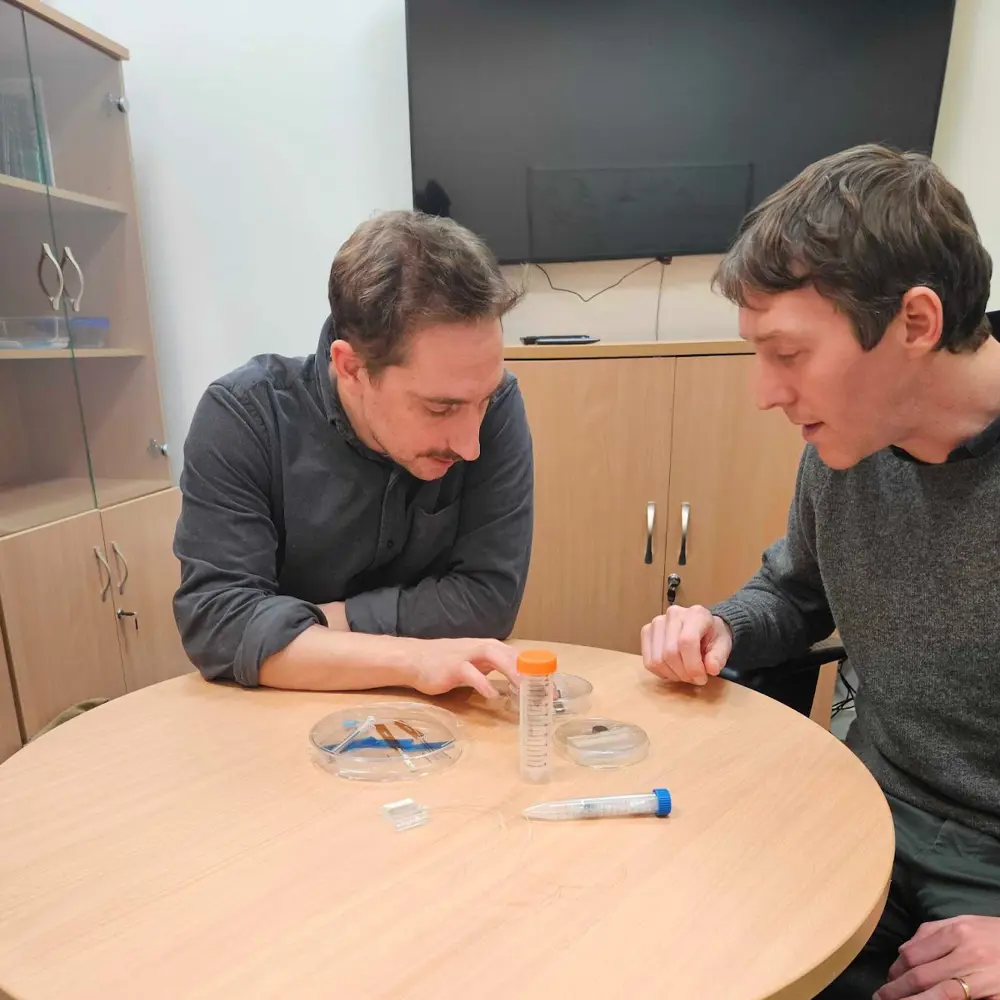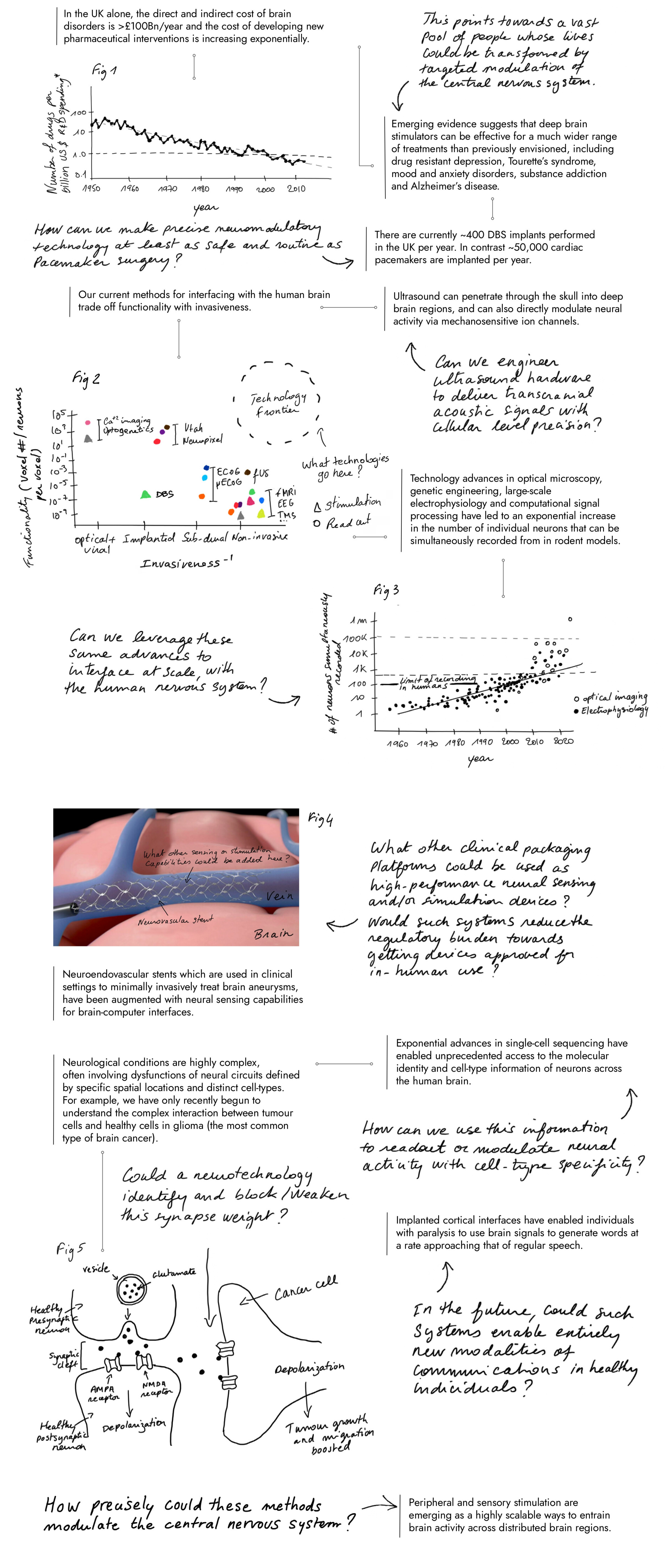
Scalable Neural Interfaces
Neurological and neuropsychiatric disorders have overwhelming societal and economic impacts. We need a new suite of tools that enable us to interface, at scale, with the human brain.
What if we could solve the mysteries of neurological disorders and mental health by interfacing with the brain in new ways?
Defined by our Programme Directors (PDs), opportunity spaces are areas we believe are likely to yield breakthroughs.
In Scalable Neural Interfaces, we are exploring how to advance highly targeted minimally-invasive neurotechnologies to understand and repair the brain.
Core beliefs
The core beliefs that underpin this opportunity space:
Targeted interaction with the human brain can improve the human condition across an incredibly wide range of disease states and cognitive domains → we need to dramatically and safely increase the throughput (no. procedures per day/£) at which these technologies can be deployed to understand their full potential and deliver them at scale.
Current paradigms for interfacing with the human brain trade off precision for invasiveness of the procedure → there’s no fundamental reason we can’t build technologies that are both highly targeted and minimally invasive.
To fully understand and treat disorders of the brain, we’ll need neural technologies that simultaneously offer chemical, temporal, and spatial specificity → this is achievable only by connecting the frontiers of engineered hardware with the frontiers of engineered biology.
Programmes
To build a programme within an opportunity space, our Programme Directors direct the review, selection, and funding of a portfolio of projects.
While the first programme in this opportunity space, Precision Neurotechnologies, is focused on the precise modulation of neural circuits, we are also working on a new thesis centred on the challenges of scaling and addressing bottlenecks around accessibility. Learn more about these below.

Precision Neurotechnologies
Many neurological and neuropsychiatric disorders are neural circuit-level disorders, or problems with the ‘wiring’ of the brain. Current technologies lack the precision to treat this and most are highly invasive. Backed by £69m, this programme seeks to develop next-generation neurotechnologies that operate at the circuit level, across distributed brain regions and with cell type specificity.
Read the programme thesis: Massively Scalable Neurotechnologies
- Neurological and neuropsychiatric disorders are the leading cause of global ill health and disability, incurring an annual economic cost exceeding $1.7 trillion in Europe and the USA.
- Current state-of-the-art neurotechnologies require complex surgical procedures, which limits access to only the most severely affected patients and excludes many who could benefit from earlier treatment.
- This programme aims to develop a new class of brain surgery-free neurotechnologies that utilise the body’s natural pathways to reach the central nervous system (CNS).
- The goal is to create responsive therapies that can be delivered systemically or minimally invasively in an outpatient setting, allowing for earlier intervention and expanding access to powerful brain treatments.
We anticipate that project teams will be highly interdisciplinary and drawn from diverse institutions and fields. To support this, we have launched a teaming platform ahead of the programme call to connect researchers and organisations.
Resources
Programme thesis (accessible version)
Share your thoughts
Teaming platform
Accessibility support
Opportunity seeds
Outside the scope of programmes, opportunity seeds support ambitious research aligned to our opportunity spaces with budgets of up to £500k.
We're funding 8 seeds to advance the field of scalable neural interfaces by exploring novel biological materials and pioneering new methods for interfacing with the nervous system.
UK National Partnership for Neurotechnology
Luke Bashford, Newcastle University
A Silence Switch for Cancer: Targeting Neural-tumour Synapses with Neuromodulation
Jake Stroud, CoherenceNeuro
Adapting Non-Pathogenic Fungal Networks Toward Next-Generation Neural Interfaces
Thomas Paterson, University of Sheffield
Oligodendronics: Engineering Biology for Scalable Neural Interfaces
Christopher Chapman, Queen Mary University of London
Non-Invasive Skilled Movement BCI Using Multimodal GPT Models
Katja Kornysheva, University of Birmingham
MAGNIS: Magnetically Guided Neural Interface System
Pietro Valdastri, University of Leeds
Scalable Neural Interfaces for Systemic Disorders via Gut-Brain Pathway Modulation
Guillaume de Lartigue, Monell Chemical Senses Center
Craniomics: Mapping the Neuro-Bone Interface in Neurodegeneration
Jake P. Taylor-King, Relation
Sign up for updates
Stay up-to-date on our opportunity spaces and programmes, be the first to know about our funding calls and get the latest news from ARIA.

